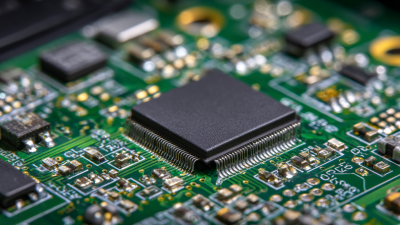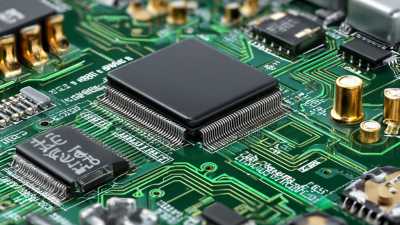 In the ever-evolving landscape of technology, the advent of Flex Circuit Boards has emerged as a pivotal turning point, driving the next wave of innovation across various industries. These highly versatile and lightweight circuit boards offer not only the flexibility to design compact and intricate electronic devices but also contribute to significant improvements in performance and reliability. As we delve into the future of innovation, it becomes evident that Flex Circuit Boards are revolutionizing how devices are conceived, enabling engineers to push the boundaries of creativity and efficiency. From consumer electronics to medical devices and automotive applications, their ability to adapt to diverse applications is reshaping our technological ecosystem. By exploring the transformative impact of Flex Circuit Boards, we can gain insights into the promising future they herald for innovation and the countless possibilities that lie ahead.
In the ever-evolving landscape of technology, the advent of Flex Circuit Boards has emerged as a pivotal turning point, driving the next wave of innovation across various industries. These highly versatile and lightweight circuit boards offer not only the flexibility to design compact and intricate electronic devices but also contribute to significant improvements in performance and reliability. As we delve into the future of innovation, it becomes evident that Flex Circuit Boards are revolutionizing how devices are conceived, enabling engineers to push the boundaries of creativity and efficiency. From consumer electronics to medical devices and automotive applications, their ability to adapt to diverse applications is reshaping our technological ecosystem. By exploring the transformative impact of Flex Circuit Boards, we can gain insights into the promising future they herald for innovation and the countless possibilities that lie ahead.
Flexible circuit boards, or flex circuits, are becoming increasingly crucial in the realm of modern electronics development. According to a recent report by MarketsandMarkets, the global flexible circuit market is expected to grow from $30.8 billion in 2021 to $46.3 billion by 2026, at a compound annual growth rate (CAGR) of 8.5%. This surge is driven by the rising demand for miniaturization in electronics, enabling manufacturers to design more compact devices without compromising on functionality or performance. Flex circuits allow for innovative designs that seamlessly integrate into various applications, from smartphones to medical devices, enhancing both usability and aesthetic appeal.
Tips for embracing flexible circuit technology include thorough planning during the design phase to fully exploit the advantages of flex circuits. Understanding the specific application requirements—such as size constraints and environmental conditions—can significantly influence the choice of materials and layouts. Additionally, considering multi-layer flex circuits can enhance performance and reduce footprint, paving the way for advancements in wearable technology and IoT devices. Staying informed about industry trends and collaborating with experienced manufacturers can further optimize design and production processes in this rapidly evolving market.
The flexible circuit board (FPC) market is witnessing remarkable growth, driven by innovations across various industries including aerospace, automotive, and consumer electronics. Projections indicate that the global market for flexible circuit boards is expected to experience a significant increase over the next decade. For instance, the aerospace and defense PCB market size is forecasted to grow from $3.641 billion in 2024 to $5.618 billion by 2032, with a compound annual growth rate (CAGR) of 5.6%. Similarly, the automotive PCB sector is anticipated to rise from $9.15 billion in 2023 to $15.1 billion by 2032, reflecting a robust CAGR of 5.9%.
Tips for businesses looking to invest in flexible circuit technology include understanding the specific needs of their applications. Consider the lifespan, flexibility, and weight reduction that flexible circuits can provide, especially in industries like automotive and aerospace where performance is critical. Furthermore, staying informed about ongoing advancements in manufacturing techniques and materials will be pivotal in leveraging these technologies effectively.
Additionally, companies should assess their supply chain capabilities to ensure they can meet the increasing demand for flexible circuit boards. Collaborating with suppliers who are aligned with innovation and sustainability could enhance product offerings and market competitiveness. Investing in research and development can also drive efficiencies and lead to the creation of next-generation flexible circuits.
This bar chart illustrates the projected market growth of flexible circuit boards over the next decade, indicating a significant increase in value as technology advances and demand rises.
Flex circuit technology is transforming the landscape of wearable devices, allowing for greater functionality and design versatility. Unlike traditional rigid circuit boards, flexible circuits can conform to the contours of various surfaces, enabling manufacturers to create slimmer, lighter, and more ergonomically designed products. This flexibility not only enhances user comfort but also provides opportunities to integrate advanced features without sacrificing performance. As devices become more compact, the ability to utilize sophisticated components within limited spaces fundamentally changes our approach to wearable technology.
The impact of flex circuit technology extends beyond mere aesthetics; it significantly enhances device functionality. It allows for the seamless integration of sensors, batteries, and communication modules, all of which contribute to the advanced capabilities of modern wearables. With robust connections and improved durability, flex circuits also support more complex applications like health monitoring, augmented reality, and real-time data processing. This evolution is essential for developing next-generation wearables that require intricate layouts and high-performance standards, making flex circuit boards pivotal in the future of personal technology.
| Feature | Flex Circuit Technology | Traditional Circuit Technology |
|---|---|---|
| Weight | Lightweight | Heavier |
| Flexibility | Highly Flexible | Rigid |
| Space Utilization | Compact Design | More Space Required |
| Manufacturing Cost | Higher Initial Cost | Lower Initial Cost |
| Durability | More Resistant to Stress | Less Durable |
| Applications | Wearable Devices, IoT | Computers, Appliances |
Flexible circuit boards (FPCs) are transforming the landscape of technology, offering distinct advantages over traditional rigid boards. Their inherent flexibility allows them to conform to various shapes and surfaces, which is particularly valuable in the burgeoning field of wearable devices. As demand for body-conformable electronics grows, FPCs enable the creation of sophisticated devices that maintain functionality without compromising comfort. Furthermore, recent innovations such as electronic ink technology have facilitated real-time switching between rigid and flexible states, unveiling new opportunities for medical implants and any technology requiring adaptability.
**Tips:** When considering the transition to flexible circuit boards, focus on the specific application requirements. Evaluate the mechanical demands and potential environments your design may encounter. Additionally, consider the integration with emerging technologies like carbon nanotube inks, which offer cost-effective solutions while enhancing circuit stability.
The market for flexible printed circuit boards is on a rapid incline, projected to expand substantially in the coming years. This growth is spurred by advancements in fabrication techniques, which are addressing previous limitations in durability and performance. For industries aiming to innovate, investing in FPC technology not only streamlines production processes but also opens doors to unprecedented design possibilities.

Flex circuit boards are increasingly becoming a cornerstone of innovation across various industries, enabling the development of cutting-edge technologies. According to a report by MarketsandMarkets, the global flexible circuit market is projected to grow from $20.5 billion in 2020 to $29.8 billion by 2025, reflecting a compound annual growth rate (CAGR) of 7.6%. This growth is driven by the rising demand for miniaturized electronic devices in sectors such as medical, automotive, and consumer electronics, where flex circuits offer significant advantages in terms of space-saving design and weight reduction.

One of the most intriguing applications of flex circuits is in the realm of wearable technology. Flex circuits can be seamlessly integrated into smart textiles, enabling real-time health monitoring and data collection. A report by IDTechEx indicates that the market for wearable electronics is expected to surpass $80 billion by 2025. As manufacturers continue to innovate, we can expect to see more sophisticated uses of flex circuits, enhancing functionality while maintaining comfort and usability.
Tips: When considering the implementation of flex circuits in your designs, prioritize selecting materials that offer both flexibility and durability. Additionally, ensure that your manufacturing processes are optimized for high precision to achieve the best performance from your flex circuits. Embracing these practices can significantly enhance the efficacy of your products in the rapidly evolving tech landscape.





